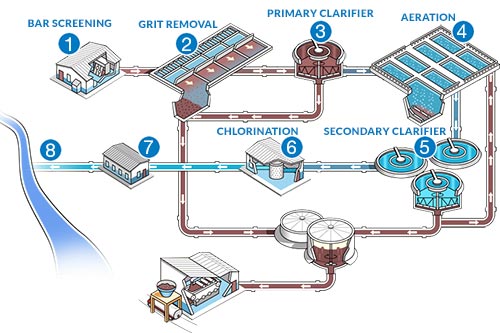Revolutionizing Wastewater Treatment with Sustainable Innovations
Revolutionizing Wastewater Treatment with Sustainable Innovations
Blog Article
Understanding Wastewater Therapy Processes and Their Ecological Impact
The intricacies of wastewater treatment procedures play a pivotal duty in mitigating ecological obstacles linked with water air pollution. Each phase, from initial to sophisticated therapies, is made to resolve specific pollutants, inevitably guarding both public wellness and marine ecological communities.
Overview of Wastewater Treatment
How is wastewater transformed into a safe resource for the setting? Wastewater treatment is an important process created to eliminate pollutants from used water, thereby guarding public wellness and shielding communities. This process starts with the collection of wastewater from household, commercial, and industrial sources, which is then guided to treatment centers.
At these centers, various physical, chemical, and organic approaches are employed to deal with the wastewater. Preliminary screening eliminates big debris, complied with by sedimentation to separate larger solids. Consequently, organic therapies, such as activated sludge procedures, utilize microbes to break down natural matter. These approaches not just reduce toxin degrees but additionally assist in the healing of valuable nutrients.
The dealt with effluent can be safely discharged right into natural water bodies or reused for irrigation and industrial purposes, promoting resource preservation. Additionally, the therapy process produces biosolids, which can be repurposed as plant foods or soil changes, further enhancing sustainability.
Phases of Therapy Procedures
The wastewater therapy procedure normally is composed of 3 main phases: initial, main, and secondary therapy. Each phase serves a distinct function in lowering the pollutant load and making sure the effluent fulfills ecological standards before discharge.

The main therapy stage focuses on the physical splitting up of put on hold solids from the wastewater. Through sedimentation, much heavier bits work out at the end of sedimentation storage tanks, developing sludge, while lighter materials, such as oils and greases, float to the surface area and are skimmed. This process considerably decreases the organic and inorganic lots in the wastewater.
Second therapy is a biological process focused on more minimizing the concentration of organic issue. Numerous techniques, including activated sludge systems and flowing filters, use microbes to metabolize organic pollutants. This stage is crucial for accomplishing the needed biochemical oxygen demand (BOD) reduction, ultimately bring about cleaner effluent ready for discharge or more therapy. Each phase is vital in guarding environmental and public wellness.

Advanced Treatment Technologies
Complying with the secondary treatment processes, progressed treatment modern technologies play an important duty in more this boosting the high quality of treated wastewater. These technologies are made to remove recurring pollutants that are not successfully eliminated find out this here during main and second therapies, making certain the effluent satisfies stringent governing criteria.
Among the commonly made use of advanced treatment approaches are membrane filtration, reverse osmosis, and progressed oxidation procedures. Membrane filtration, including microfiltration and ultrafiltration, is reliable in separating fine bits, virus, and colloids from the water (Wastewater). Reverse osmosis makes use of semi-permeable membranes to eliminate liquified solids, causing top quality water appropriate for numerous applications
Advanced oxidation procedures (AOPs) use strong oxidants to deteriorate natural contaminants, consisting of drugs and individual treatment products that are resistant to conventional treatment. These techniques improve the biodegradability of intricate substances, promoting their elimination.
An additional substantial technology is the use of biological nutrient elimination processes, which particularly target nitrogen and phosphorus, protecting against eutrophication in obtaining water bodies. Overall, advanced therapy technologies are important for achieving higher levels of purification, advertising water reuse, and guarding public wellness while resolving the obstacles connected with wastewater monitoring.
Ecological Benefits of Treatment
Many ecological advantages develop from efficient wastewater therapy procedures that contribute to ecosystem health and wellness and sustainability. Mostly, these procedures dramatically lower the launch of damaging contaminants into all-natural water bodies, which assists maintain aquatic environments. By eliminating pollutants such as heavy steels, nutrients, and virus, dealt with wastewater Discover More reduces the risk of waterborne conditions and advertises biodiversity in marine settings.
In addition, wastewater treatment facilities often employ sophisticated technologies that allow water recycling and reuse. This practice not just preserves fresh water resources but additionally lowers the need on all-natural water products. Boosted nutrient elimination from wastewater can likewise avoid eutrophication, a process that results in algal blossoms and subsequent oxygen deficiency in water systems.
In addition, efficient therapy processes can lessen greenhouse gas emissions, specifically methane and laughing gas, which are often launched during without treatment wastewater disintegration. By recording and making use of biogas from anaerobic digesters, centers can convert waste right into renewable resource, therefore contributing to a decrease in nonrenewable fuel source reliance.
Obstacles and Future Trends
While the ecological advantages of wastewater treatment are clear, a number of obstacles linger that hinder ideal end results in this area. One major problem is maturing framework, which typically brings about inefficiencies and enhanced functional expenses - Wastewater. Many treatment plants were created years earlier, and their capabilities do not line up with contemporary needs, which consist of more stringent governing standards and higher volumes of wastewater because of urbanization

Looking ahead, there is an expanding emphasis on resource recuperation and circular economy concepts within wastewater treatment. Innovations such as anaerobic food digestion, which can create biogas, and progressed filtering technologies are gaining grip. These methods not just improve treatment effectiveness but additionally promote sustainability.
Ultimately, addressing these obstacles needs cooperation among stakeholders, investment in innovation, and a commitment to continuous research. By accepting these trends, the wastewater treatment sector can progress to meet the needs of a changing setting and society.
Verdict
In final thought, wastewater therapy procedures play a vital role in enhancing environmental high quality and public health and wellness. The multi-stage therapy structure, paired with innovative modern technologies, effectively mitigates pollution and promotes sustainable water administration.
Report this page